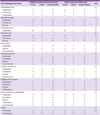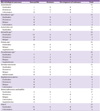1. Dagan R, Leibovitz E, Greenberg D, Yagupsky P, Fliss DM, Leiberman A. Early eradication of pathogens from middle ear fluid during antibiotic treatment of acute otitis media is associated with improved clinical outcome. Pediatr Infect Dis J. 1998; 17:776–782.

2. Guillemot D, Carbon C, Balkau B, Geslin P, Lecoeur H, Vauzelle-Kervroëdan F, Bouvenot G, Eschwége E. Low dosage and long treatment duration of beta-lactam: risk factors for carriage of penicillin-resistant Streptococcus pneumoniae. JAMA. 1998; 279:365–370.
3. Ghaffar F, Muniz LS, Katz K, Reynolds J, Smith JL, Davis P, Friedland IR, McCracken GH Jr. Effects of amoxicillin/clavulanate or azithromycin on nasopharyngeal carriage of
Streptococcus pneumoniae and
Haemophilus influenzae in children with acute otitis media. Clin Infect Dis. 2000; 31:875–880.

4. Dagan R, Klugman KP, Craig WA, Baquero F. Evidence to support the rationale that bacterial eradication in respiratory tract infection is an important aim of antimicrobial therapy. J Antimicrob Chemother. 2001; 47:129–140.

5. Schrag SJ, Peña C, Fernández J, Sánchez J, Gómez V, Pérez E, Feris JM, Besser RE. Effect of short-course, high-dose amoxicillin therapy on resistant pneumococcal carriage: a randomized trial. JAMA. 2001; 286:49–56.

6. Ghaffar F, Muniz LS, Katz K, Smith JL, Shouse T, Davis P, McCracken GH Jr. Effects of large dosages of amoxicillin/clavulanate or azithromycin on nasopharyngeal carriage of
Streptococcus pneumoniae,
Haemophilus influenzae, nonpneumococcal alpha-hemolytic streptococci, and
Staphylococcus aureus in children with acute otitis media. Clin Infect Dis. 2002; 34:1301–1309.

7. Garau J. Why do we need to eradicate pathogens in respiratory tract infections? Int J Infect Dis. 2003; 7:Suppl 1. S5–S12.

8. Stratton CW. Dead bugs don't mutate: susceptibility issues in the emergence of bacterial resistance. Emerg Infect Dis. 2003; 9:10–16.

9. De Lencastre H, Tomasz A. From ecological reservoir to disease: the nasopharynx, day-care centres and drug-resistant clones of Streptococcus pneumoniae. J Antimicrob Chemother. 2002; 50:Suppl S2. 75–81.
10. Forrest A, Nix DE, Ballow CH, Goss TF, Birmingham MC, Schentag JJ. Pharmacodynamics of intravenous ciprofloxacin in seriously ill patients. Antimicrob Agents Chemother. 1993; 37:1073–1081.

11. Fink MP, Snydman DR, Niederman MS, Leeper KV Jr, Johnson RH, Heard SO, Wunderink RG, Caldwell JW, Schentag JJ, Siami GA, Zameck RL, Haverstock DC, Reinhart HH, Echols RM. Severe Pneumonia Study Group. Treatment of severe pneumonia in hospitalized patients: results of a multicenter, randomized, double-blind trial comparing intravenous ciprofloxacin with imipenem-cilastatin. The Severe Pneumonia Study Group. Antimicrob Agents Chemother. 1994; 38:547–557.

12. Thomas JK, Forrest A, Bhavnani SM, Hyatt JM, Cheng A, Ballow CH, Schentag JJ. Pharmacodynamic evaluation of factors associated with the development of bacterial resistance in acutely ill patients during therapy. Antimicrob Agents Chemother. 1998; 42:521–527.

13. Beam TR Jr, Gilbert DN, Kunin CM. Infectious Diseases Society of America and the Food and Drug Administration. General guidelines for the clinical evaluation of anti-infective drug products. Clin Infect Dis. 1992; 15:Suppl 1. S5–S32.

14. Chow AW, Hall CB, Klein JO, Kammer RB, Meyer RD, Remington JS. Infectious Diseases Society of America and the Food and Drug Administration. Evaluation of new anti-infective drugs for the treatment of respiratory tract infections. Clin Infect Dis. 1992; 15:Suppl 1. S62–S88.

15. Charlson ME, Pompei P, Ales KL, MacKenzie CR. A new method of classifiying prognostic comorbidity in longitudinal studies: development and validation. J Chronic Dis. 1987; 40:373–383.

16. Clark RB, Janda JM, Bottone EJ. Phenotypic factors correlated with the absence of virulence among gentamicin-resistant
Pseudomonas aeruginosa strains. J Clin Microbiol. 1984; 20:235–238.

17. Ravizzola G, Pirali F, Paolucci A, Terlenghi L, Peroni L, Colombi A, Turano A. Reduced virulence in ciprofloxacin-resistant variants of
Pseudomonas aeruginosa strains. J Antimicrob Chemother. 1987; 20:825–829.

18. Andersson DI, Levin BR. The biological cost of antibiotic resistance. Curr Opin Microbiol. 1999; 2:489–493.

19. Ramisse F, van Delden C, Gidenne S, Cavallo J, Hernandez E. Decreased virulence of a strain of
Pseudomonas aeruginosa O12 overexpressing a chromosomal type 1 beta-lactamase could be due to reduced expression of cell-to-cell signaling dependent virulence factors. FEMS Immunol Med Microbiol. 2000; 28:241–245.

20. Di Martino P, Gagnière H, Berry H, Bret L. Antibiotic resistance and virulence properties of
Pseudomonas aeruginosa strains from mechanically ventilated patients with pneumonia in intensive care units: comparison with imipenem-resistant extra-respiratory tract isolates from uninfected patients. Microbes Infect. 2002; 4:613–620.

21. Sánchez P, Linares JF, Ruiz-Díez B, Campanario E, Navas A, Baquero F, Martínez JL. Fitness of in vitro selected Pseudomonas aeruginosa nalB and nfxB multidrug resistant mutants. J Antimicrob Chemother. 2002; 50:657–664.
22. Andersson DI. Persistence of antibiotic resistant bacteria. Curr Opin Microbiol. 2003; 6:452–456.

23. Kugelberg E, Löfmark S, Wretlind B, Andersson DI. Reduction of the fitness burden of quinolone resistance in
Pseudomonas aeruginosa. J Antimicrob Chemother. 2005; 55:22–30.

24. Prince AS. Biofilms, antimicrobial resistance, and airway infection. N Engl J Med. 2002; 347:1110–1111.

25. Fux CA, Costerton JW, Stewart PS, Stoodley P. Survival strategies of infectious biofilms. Trends Microbiol. 2005; 13:34–40.

26. Garcia-Medina R, Dunne WM, Singh PK, Brody SL.
Pseudomonas aeruginosa acquires biofilm-like properties within airway epithelial cells. Infect Immun. 2005; 73:8298–8305.

27. Wunderink RG. Surrogate markers and microbiologic end points. Clin Infect Dis. 2010; 51:Suppl 1. S126–S130.








 PDF
PDF ePub
ePub Citation
Citation Print
Print





 XML Download
XML Download